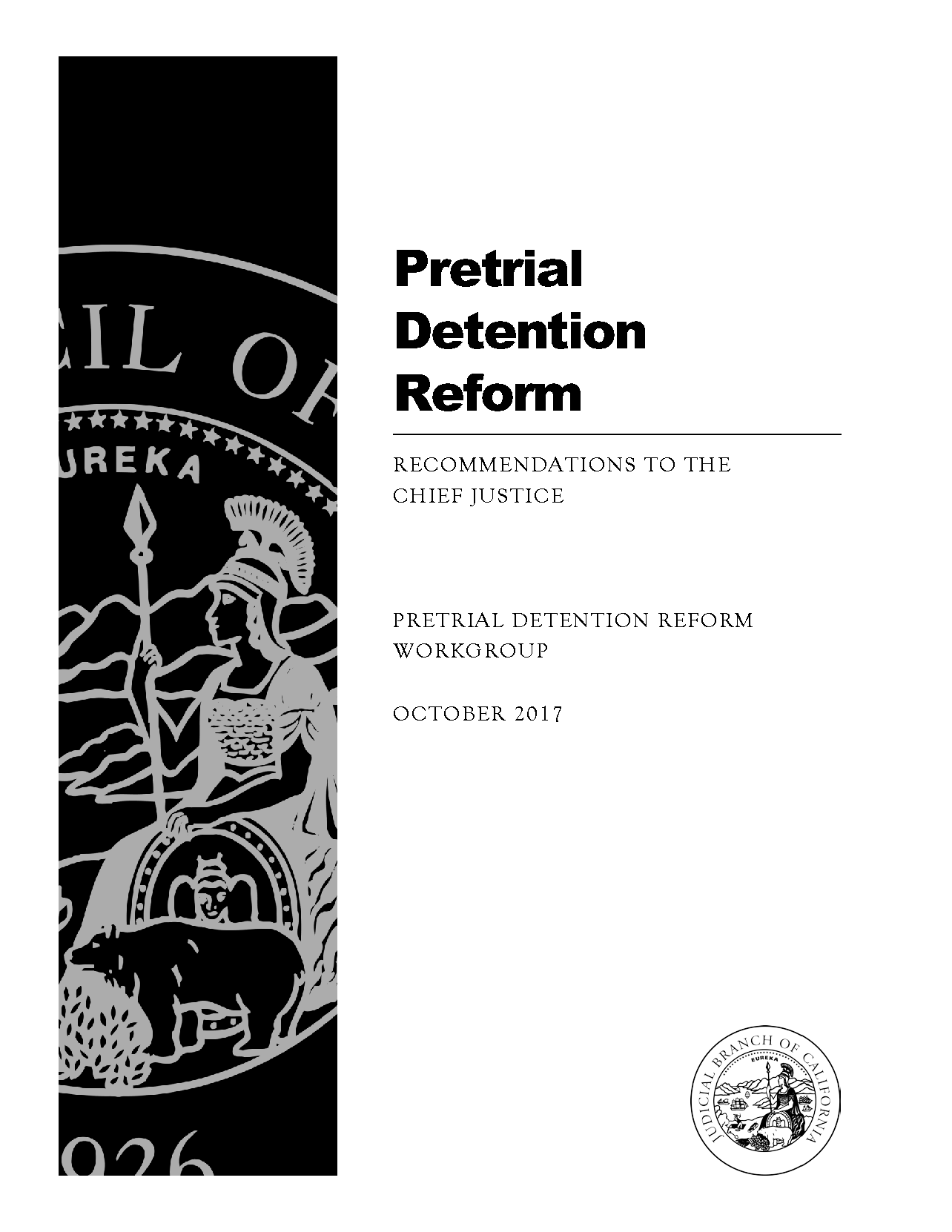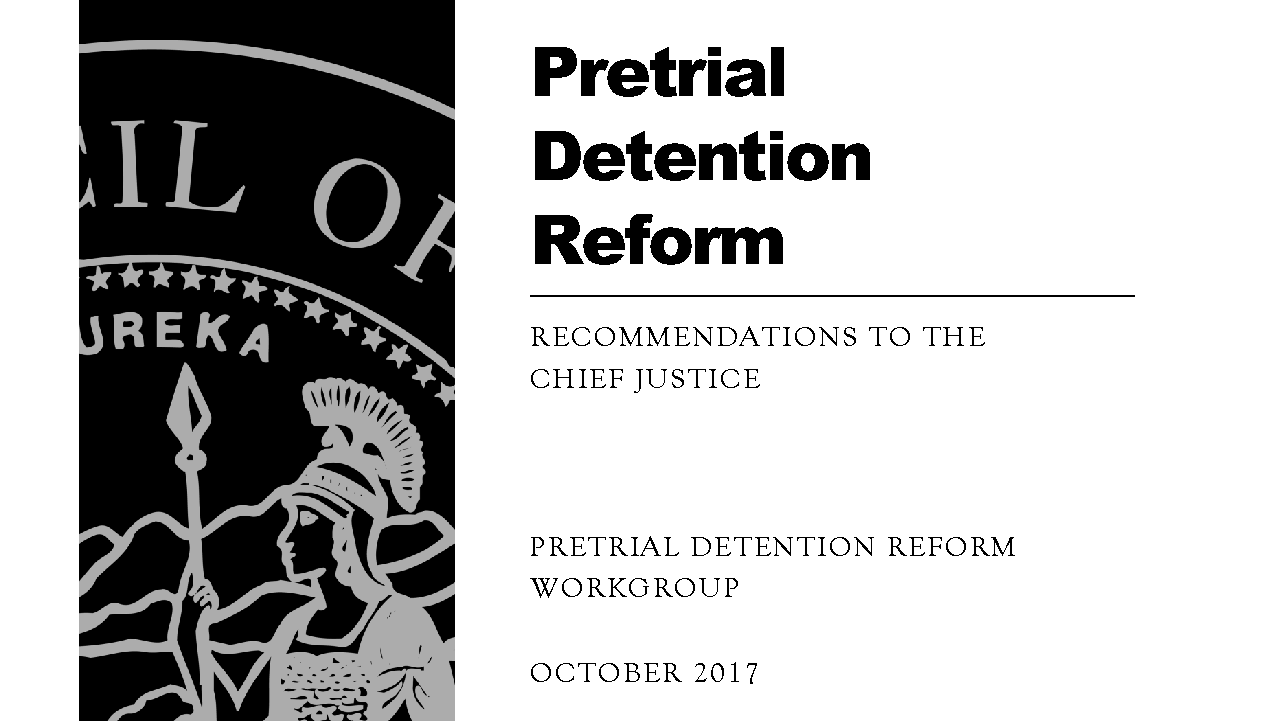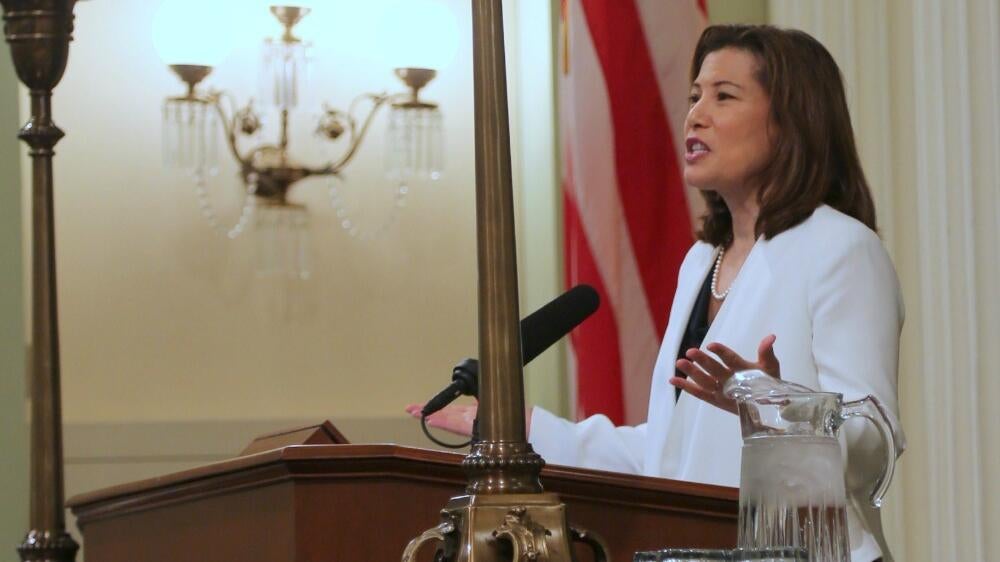Frequently Asked Questions: Pretrial Detention Reform
**Updated November 6, 2017**
What is the Pretrial Detention Reform Workgroup?
After calling for a review of the bail system during her 2016 State of the Judiciary address, Chief Justice Tani G. Cantil-Sakauye established the Pretrial Detention Reform Workgroup in October 2016 to study the current system and to develop recommendations for reform. Its membership includes 11 trial court judges and one court executive officer. Judges range in the number of years they have served on the bench, court size and geography, as well as their backgrounds as prosecutors, public defenders, law enforcement or in private practice.
What input did the workgroup receive?
The workgroup received in-person presentations from more than 40 speakers, including: state and national experts; justice system partners; government agencies; the commercial bail industry; regulators; victim and civil rights advocates; California counties with experience with pretrial services programs (Humboldt, Imperial and Santa Clara Counties); and jurisdictions outside of California that have undertaken bail reform efforts (Washington, D.C.; Kentucky; New Jersey; and New Mexico).
What are the next steps?
The Chief Justice will accept the report’s recommendations, present them to the Judicial Council in November, and suggest the way in which she would like to have the judicial branch move forward on this issue. To be successfully implemented, the recommended changes will require action from the Legislature and Governor Brown, as well as the judicial branch.
What percentage of California inmates are unsentenced?
Approximately two-thirds of California’s jail population—or nearly 48,000 people—are unsentenced, according to the Board of State and Community Corrections’ annual Jail Profile Survey. This includes both people who are eligible for release but have not (or cannot) post bail and those not eligible for release.
How large is California’s for-profit bail industry?
In 2016, there were approximately 3,200 licensed bail agents, 155 bail agencies, and 17 sureties conducting business in California, according to the California Department of Insurance (CDI). A CDI report from 2011-2013 found bail agents each year posted an average of 205,000 bail bonds and collected an average of $308 million in non-refundable premium fees from defendants, their friends and families.
Why do bail amounts vary from county to county in California?
California law mandates each of California’s 58 superior courts develop a uniform countywide schedule of bail, using methods determined by each superior court. As a result, bail schedule amounts for the same offense can vary widely from county to county. For example, bail amounts for residential burglary range from $30,000 in Fresno County to $100,000 in San Francisco County.
Why is California considering overhauling its current for-profit bail system?
Many leaders from all three branches of government recognize the current for-profit bail system often penalizes those who are unable to post bail, and at the same time, the bail system is not effective at protecting public safety because it bases release on financial ability to pay rather than on risk to the community. People who are unable to afford the fee charged for a bail bond remain in jail and may lose their jobs, homes, and families. In her 2016 State of the Judiciary Address, Chief Justice Cantil-Sakauye expressed concern about the effectiveness of the current bail system in assuring public safety and appearance in court. She also raised the question whether or not bail effectively serves its purpose, and whether a risk assessment system would be more effective. She underscored that “we must not penalize the poor for being poor.”
What are the social impacts of for-profit money bail, and does it disproportionately impact certain groups?
A 2007 U.S. Department of Justice report found states have increased their reliance on bail bonds in recent years. The number of pretrial inmates in jail has grown at a much faster pace than sentenced inmates despite historically low crime rates.
Being detained for even short periods of time can threaten a person’s job, housing, child custody and access to health care. While research is mixed on linking pretrial detention with the probability of conviction and incarceration, many defendants plead guilty at an early stage in order to get out of jail. Research also shows black and Latino defendants are more likely to be detained pretrial than white defendants, and less likely to be able to post money bail as a condition of release. For those who are able to bail out, the bond fees are often paid by family and friends who may have to pay the fees on an installment plan or put up collateral; anecdotal information indicates that women are frequently posting bail on behalf of family members.
Have other U.S. states implemented bail reform?
In recent years, New Jersey and New Mexico instituted sweeping reforms to limit or end money bail. For decades, Kentucky and Washington, D.C. have run systems that primarily rely on risk assessments with very limited use of money bail. Beyond these reforms, lawmakers in 44 states and Washington, D.C. enacted 118 new laws during 2016 addressing pretrial release and detention.
What California counties have used pretrial assessment systems?
A 2015 survey of counties indicated 46 of the 58 California counties have some type of pretrial program, and 70% established their programs in the past five years. However, Santa Clara, San Francisco, Humboldt, Riverside, Imperial, and Santa Cruz Counties have had pretrial programs for many years. At least 49 counties use a type of pretrial risk assessment tool that provides judges with information about the risk of releasing a defendant before trial.
If some counties already have pretrial programs, why is reform needed?
Although the pretrial services currently in place in counties show promising results, current law and county practices substantially limit the scope of pretrial services in California. Most California counties have implemented some form of pretrial services; however, the level of provided services varies widely from county to county. Additionally, most counties have eligibility restrictions on pretrial assessment, and under the current system individuals are able to bail out prior to assessment. These capacity and legal restrictions indicate the need for expansion of pretrial services as one important element of the reform of the current monetary bail system.
What are the benefits of a pretrial assessment system?
The goal of risk assessment-based pretrial programs is to release people from custody with conditions that will help to ensure their return to court and protect public safety, and to preventively detain only those for whom no set of conditions will assure public or victim safety. While national data is limited, jurisdictions that have implemented robust risk assessment-based pretrial systems report low rates of re-arrest for those released as well as low rates of failure to appear. For example, in Kentucky, the Pretrial Services agency recommends release on own recognizance in 89% of cases involving low-risk defendants, in 60% of moderate-risk cases, and in 50% of high-risk cases. For those high-risk defendants who are released, 71% do not have a failure to appear and 86% are not rearrested during the pretrial period. Many low and moderate-risk cases require only minimal monitoring, such as court date reminders and monthly check-ins, while higher risk cases benefit from increased supervision which can include more frequent check-ins, drug testing, and electronic monitoring.
How do you assure someone will show up to court without a financial guarantee?
As noted above, Kentucky, Washington, D.C., and other jurisdictions with robust pretrial programs that do not rely on financial guarantees have low failure to appear rates. The most promising method identified to date for reducing failures to appear is to text, call or mail court date reminders to defendants.
How would these recommendations protect victims’ rights?
The proposals require a victim’s perspective to be fully integrated into the process, and the risk to their wellbeing addressed. Under the current system, if a defendant has enough money to bail out, it is often without any conditions placed on their release.
Under the workgroup’s recommendations, special consideration would be required in cases involving intimate partner violence, child abuse, stalking, and sexual assault, as perpetrators may be part of the victim’s family and their incarceration or release could more greatly affect the victim’s physical, economic, and psychological well-being–including the pressure to post bail. Specialized, validated risk assessment and supervision methods must be used for cases involving these particularly vulnerable populations. If the accused is released before trial, proper conditions—such as protective orders and electronic monitoring—must be available and ordered with intensive supervision and monitoring.
Does this proposal limit a judge’s discretion to decide who to jail or release before trial?
The proposal calls for pretrial services that will provide verified information to aid judges in the decision about whether a defendant is a risk to the public or likely to return to court. In addition, pretrial services will implement the supervision conditions that judges impose, including drug testing, home confinement and text reminders for court dates. Judges would not be bound by the pretrial services recommendations, but they would serve to help inform judges’ decisions. Judges remain the final authority in making release or detention decisions.
Under the current system, bail amounts for each trial court are set by a uniform schedule, which consider only the defendant’s current charges. In some cases, defendants can bail out before they ever go before a judge.
Does the workgroup’s recommendations mean an algorithm will decide who is eligible for release before trial?
No. The algorithm simply indicates the level of a person’s risk to reoffend or fail to appear. Under the workgroup’s recommendations, and in every jurisdiction that has implemented risk-based pretrial release, judicial officers remain the final authority in making release or detention decisions. The risk-level information obtained from the risk assessment tool, combined with the recommendation provided by Pretrial Services, will inform the judge’s decision. But in every case the judicial officer can override the recommendation.
Would tools used to assess a defendant’s risk be open to outside review?
The proposals require that any risk assessment tools be transparent about the factors and algorithm used to decide a defendant’s risk, and mandates these tools be validated regularly. Tools that show any implicit or explicit bias must not be used, and cases involving intimate partner violence or sexual assault require specialized risk assessment.
Will this proposal require a change to California’s Constitution?
A risk-based system appears to be permissible under the California Constitution, although there has not been a definitive interpretation in case law of the current constitutional provisions that govern pretrial release and detention.




